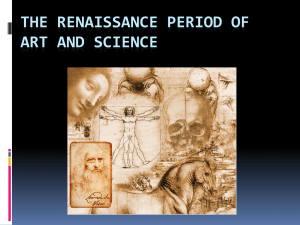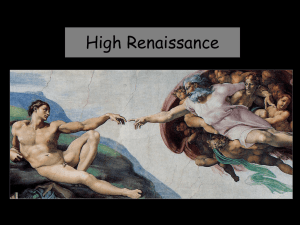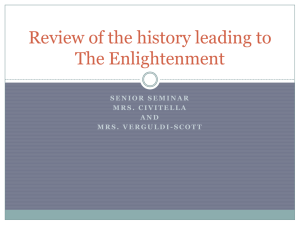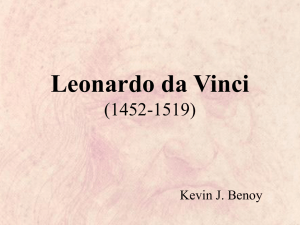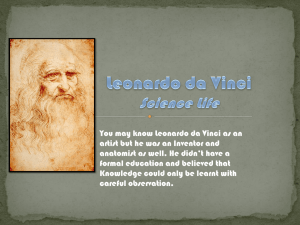Leonardo da Vinci
advertisement
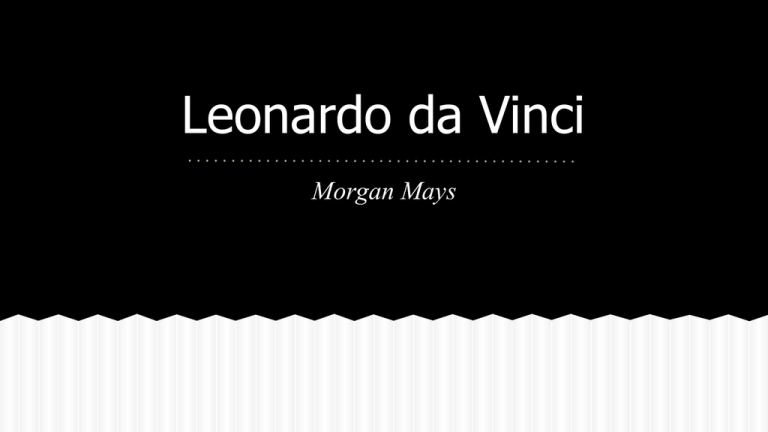
Leonardo da Vinci Morgan Mays Significance of the Renaissance Put in simple terms, the Renaissance was a Rebirth of Europe. It was breaking away from the Dark Ages where everyone thought of themselves as a community rather than as an individual. The Renaissance dealt with many different changes which aided in the switch from the thought of being part of a community to the thought of being an individual. There were changes in art, architecture, literature, science, technology, politics, and religion, among many more. These changes dealt with the four “isms”: humanism, individualism, secularism, and scientific naturalism. Humanism was a basic liberal arts education in which turned the European people into well-rounded individuals. Individualism was the narcissistic belief of being an individual, which emphasized individual achievement. Secularism changed people to believe more in the “here and now” rather than the future. They became more materialistic rather than spiritual; this caused many to separate from the church and think for themselves. Scientific naturalism made a shift to studying science and how people react in their natural habitat. This put a focus on geometry and anatomy. With the help of these “isms” and changes in society, the Renaissance became an important part of history. Art by Leonardo da Vinci The Mona Lisa was believed to be painted between 1503 and 1506. The painting is a portrait of Lisa Gioconda, a wealthy Florentine merchant’s wife, which was supposed to be delivered to the merchant. This was not the case, as somehow Leonardo da Vinci ended up keeping the portrait when he went to work for the King of France. The Mona Lisa has been acclaimed as "the best known, the most visited, the most written about, the most sung about, the most parodied work of art in the world." Mona Lisa Art by Leonardo da Vinci Leonardo da Vinci painted The Last Supper because his employer told him to. da Vinci worked for Ludovico Sforza, Duke of Milan, who asked for this particular art piece. This painting was constructed from 1495-1498. The Last Supper is is one of the world's most famous paintings, and one of the most “studied, scrutinized, and satirized.” The Last Supper Art by Leonardo da Vinci Annunciation Annunciation was painted between 1472 and 1475 and is thought of to be one of Leonardo da Vinci’s first complete paintings. It was painted when da Vinci was still working under his master, Verrocchio. The painting is believed to be a collaboration between da Vinci and Verrocchio. The inspiration for the painting is from Luke 1:26-39 and depicts the angel Gabriel announcing to Mary that she would give birth to a son. Biography of Leonardo da Vinci Leonardo da Vinci was born on April 15, 1452 in Vinci, Italy. He was an artist, writer, mathematician, inventor, sculptor, and draftsman. da Vinci was concerned with the laws of science and nature (which deals with the scientific naturalism of the Renaissance). At age 14, da Vinci began working with the artist Verrocchio, where he learned many of the techniques he later used as an artist. In 1482, da Vinci was commissioned to create a silver lyre for Ludovico il Moro, the Duke of Milan. He did so, while also including a letter describing his artistic talents and how he would be of great service to the Duke. The Duke hired him, which brought many projects to da Vinci, including the project to paint The Last Supper. He worked for Ludovico from 1482-1499. After working for Ludovico, da Vinci was asked to do a private commissioned art piece. He was asked to paint a portrait of Lisa Gioconda. He completed the project, however it was never delivered to the commissioner. da Vinci kept the painting with him until the end of his life. Now, the Mona Lisa is one of the most known art pieces in the world. Leonardo da Vinci created many other paintings that contributed to the Renaissance. “Isms” on the Mona Lisa Humanism: Humanism was an intellectual movement based on the study of the classics. Studying the classics had the goal of creating well-rounded individuals, which was helped by reestablishing human values. In the Renaissance, there was a new view of humankind being created: man was viewed as the center of the universe, man’s dignity was glorified, and many believed in the potential of human. The Mona Lisa reflects the ideas of humanism by making the portrait of the person the focal point of the art piece. This signifies that man is the center of the universe, while also glorifying the dignity of man. Humanism was about focusing the view on perfecting one’s self, which is shown through the woman being focused on in the Mona Lisa. Mona Lisa and the Spirit of the Renaissance Individualism: Individualism focused on individual achievement. This caused man to begin to think, act, and speak for himself. Before the Renaissance, man thought of himself as being part of a community. The Renaissance changed the thinking of man to make him view himself as an individual. Individualism was very narcissistic. Individualism is probably the most prominent “ism” in the Mona Lisa because it clearly shows a portrait of a woman. The purpose of portraits are to focus on the individual. It obviously shows individualism because it shows a single woman rather than a group of people. “Isms” on the Mona Lisa Secularism: Secularism was the shift from people being concerned with religion and the future to people being concerned with materialistic things and the present. Man became more focused on money, wealth, material goods, leisure, and activities. Secularism resulted in many people separating themselves from the Church. The Mona Lisa does show secularism because it is not religious themed. Many of da Vinci’s other paintings dealt with religion. The Mona Lisa rather focuses on wealth, since only the wealthy could afford to be painted. The Mona Lisa shows secularism since it represents a shift from religious to materialistic things. “Isms” on the Mona Lisa Scientific Naturalism: Scientific naturalism is the study of the natural world. People began to study science, anatomy, proportions, and laws of perspective. People became concerned with humans in their natural environment. Scientific naturalism was portrayed in literature and art as showing things as being realistic. The Mona Lisa portrays scientific naturalism in ways dealing with anatomy. The features of the woman being painted are very realistic and life-like. Leonardo da Vinci spent years completing the Mona Lisa to ensure that the proportions and body parts were like those of humans. The Mona Lisa is portrayed as a realistic woman. Mona Lisa and the Spirit of the Renaissance The Mona Lisa illustrates the spirit of the Renaissance because it portrays the main ideas of the time period of the Renaissance, including the four “isms.” The main ideas of the Renaissance included thinking of oneself as an individual, improving oneself, moving away from religion, and learning and education. The Mona Lisa is a portrait of a woman. This shows thinking of oneself as an individual because it depicts a single person, rather than a group. This shows individualism. Having one woman be the focal point would allow her traits to be glorified, which is humanism. Mona Lisa and the Spirit of the Renaissance The Mona Lisa also illustrates the spirit of the Renaissance by not being a religious painting. Many art forms previous to the Renaissance depicted a religious theme. The Mona Lisa begun the shift away from religious art pieces. This shift is an example of secularism. The Mona Lisa also depicts scientific naturalism. Looking at the anatomical features of the woman being pictured, one can see how proportional and accurate they are. This accuracy was a result of Leonardo da Vinci studying anatomy and proportions to create realism in this piece. Mona Lisa and the Spirit of the Renaissance Overall, the Mona Lisa is a perfect example of how artwork portrays time periods accurately. The Mona Lisa hits all of the main points of the Renaissance. It easily shows each of the four “isms” to sum up the rebirth of the time period. Unknowingly, Leonardo da Vinci created an art piece that has helped historians define the Renaissance.

